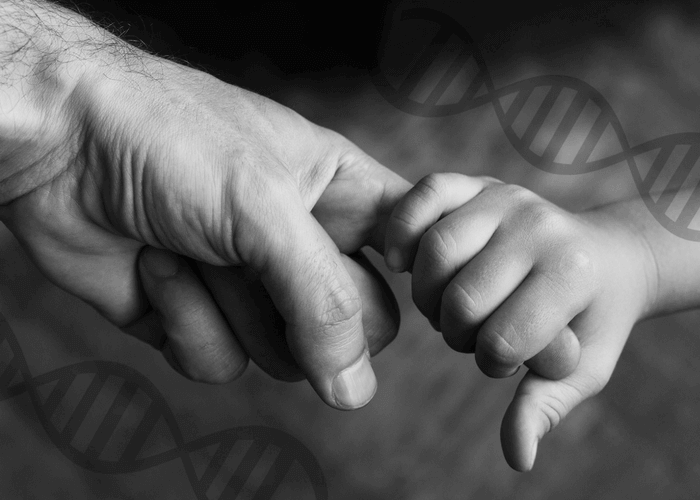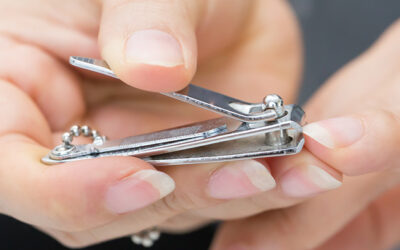
DNA science has revolutionized the paternity and family relationship testing industry with a higher power of discrimination among individuals, non-invasive sample collection options, and faster turnaround time. Get your geek on and learn information about the properties of DNA that make it especially useful for paternity testing. You can also learn details about the paternity testing process, including interpreting results.
DNA Science: DNA is Inherited from Both Biological Parents
DNA, also known as deoxyribonucleic acid, is found in all cells of the body. It is composed of four different molecules—adenine (A), thymine (T), cytosine (C), and guanine (G). Like the letters of an alphabet, these four molecules are arranged in strings of specific sequences that spell out instructions for our body’s everyday functions. DNA contains information that dictates our physical characteristics, such as facial features, height, and even health.
During conception, the father’s sperm cell and the mother’s egg cell, each containing half the amount of DNA found in other body cells, meet and fuse to form a fertilized egg, called a zygote. The zygote contains a complete set of DNA molecules, a unique combination of DNA from both parents. This zygote divides and multiplies into an embryo and later, a full human being.
At each stage of development, all the cells forming the body contain the same DNA—half from the father and half from the mother. It is this fact that enables scientists to use a variety of sampling methods for DNA testing. We can take samples at virtually any stage of development and from any part of the body—and still obtain the same results, because these samples contain the same DNA.
Each person has a unique genetic profile that reflects this inheritance.

Special locations (called loci) in human DNA display predictable inheritance patterns that could be used to determine biological relationships. These locations contain specific DNA sequences, called markers, that forensic and DNA scientists use as identifying marks for individuals. In a routine DNA paternity test, the markers used are Short Tandem Repeats (STRs), short pieces of DNA that occur in different repeat patterns among individuals.
Each person’s DNA contains two copies of these markers—one copy inherited from the father and one from the mother. Within a population, the markers at each person’s DNA location could differ in length and sometimes sequence, depending on the markers inherited from the parents.
The combination of marker sizes found in each person represents his/her genetic profile. DDC examines a minimum of 16 STR markers to create a genetic profile for each tested person in a paternity, identity, or family relationship test.
DNA Science: DDC Takes DNA Samples from Each Person to Create Individual Genetic Profiles
DDC obtains DNA samples from buccal (cheek) swabs for testing and analysis. Buccal swabs are like cotton swabs, but we use a special Dacron® polymer instead of cotton to provide a consistent surface for DNA collection. When the samples reach our laboratory, our staff checks each sample package as it arrives, checking for signs of tampering. If the package is intact, it then undergoes our proprietary Dual Process™ DNA testing procedure. Two independent teams do the following:
- Review accompanying documents to make sure all forms are properly filled out
- Assign the case number and create a record for the sample
- Take half of the buccal swab samples and purify DNA from the swabs. DNA purification and isolation is performed using our Biomek® robotics systems
- Perform the polymerase chain reaction (PCR) to make billions of copies of the DNA markers
- Analyze the PCR products using the ABI Prism® 3100 genetic analyzer. These detect the marker sizes in each sample, generating the raw data
The staff carefully tracks the samples and verifies completion of each step throughout the Dual Process™. The raw data from the two teams are reviewed by the laboratory director. If the data shows no anomalies, statistical calculations can then be performed on the genetic profiles of each tested party.
In a paternity test, the genetic profiles are compared to see if the child’s profile has pieces matching the tested father and mother
A paternity test report lists the genetic profiles of each tested party, noting the allele sizes of the different markers tested. It also lists the Paternity Index (PI) for each marker—a statistical measure of how strongly a match at a particular locus signifies paternity. The table below shows partial results of a paternity test. The sizes of three of each person’s markers are shown. The numbers in red signify markers the child inherited from the mother, and those in blue signify markers inherited from the father.
| Locus | PI | Mother | Child | Alleged Father | |
| 1 | D8S1179 | 10.30 | 13, 14 | 14, 16 | 13, 16 |
| 2 | THO1 | 2.32 | 7, 9.3 | 8, 9.3 | 7, 8 |
| 3 | CSF1PO | 17.75 | 10, 11 | 7, 10 | 7 |
| *In the above table, only one value is given for the alleged father’s CSF1PO—this means that he inherited the same size of markers from his parents. | |||||
The paternity index (PI) is zero if none of the child’s markers at a specific locus matches the alleged father’s markers. The PI is 1.0 or greater if there is a match, and the actual value depends on the frequency of the marker in the population. For example, CSF1PO in line 3 of the table above shows that there is a 1 in 17.75 chance that another random, untested person (instead of the tested alleged father) could have passed on the same marker to the tested child. This PI is stronger than the other two, probably because those two markers are more commonly found in the population.
The PI’s for each marker are multiplied with each other to produce the Combined Paternity Index (CPI), which represents the overall odds that another random, untested male would have the same results if his genetic profile were compared with the child’s. The CPI is then converted into a Probability of Paternity value, which specifies the probability that the tested man is the father.
Our laboratory often achieves a Probability of Paternity of at least 99.999%—indicating that there is only a minute, 0.001% probability that another random individual in the population could have the same paternity test results and be the child’s biological father.
YOUR TEST MADE SIMPLER: HOW TO UNDERSTAND PATERNITY-TEST RESULTS >
In other family relationship tests, genetic profiles of participants are compared to see if the expected degree of shared DNA exists
The DNA science test report in other family relationship tests, such as grandparentage and siblingship tests, is similar to a paternity test report. Instead of the Combined Paternity Index, a different value, such as a Siblingship Index, is reported.
The report shows the genetic profiles of each tested person. If there are markers shared among the tested individuals, the probability of biological relationship is calculated to determine how likely the tested individuals share the same markers due to a blood relationship.
There are a variety of DNA markers that can be used to determine family relationships, identify individuals, even deduce their ancestry. For more information, please read our article, Solving Crimes and Mysteries.




How do you test with someone to confirm they are your aunt? Can that be done?
Hi, Jana. Yes, you can definitely confirm an aunt/niece relationship through DNA testing. You can learn more at the link below, and you’re welcome to call one of our DNA specialists for a free, no-obligation consultation at 800-681-7162 (M-F, 8 am to 8 pm Eastern). https://dnacenter.com/relationship-testing/avuncular/
Can you test to see if two people are related?
Hi, Pat. Our tests answer more specific questions such as, “Is Person A the father of Person B?”. There are ancestry tests on the market that provide clues to other types of more general relationships.
I understand that paternal relations (father/mother to son/daughter) should give about a 99.999% result. What would be the percentage result in an uncle/aunt to neice/nephew relationship?
Hi, Esther. Any probability of relationship 90% or higher is considered an inclusion for this type of relationship.
My daughters potential father lives in another state but his first cousin lives here can I test him to compare to family relation to my daughters potential father?
Hi, Nicole. Unfortunately, a cousin relationship is not close enough for this type of testing. Cousins only share 12.5% of the same DNA. However, the potential father living in another state isn’t a problem. If you order a paternity test from us, we send testing materials to all parties. If you are concerned he might not submit his own DNA for an at-home test, then I suggest you order a legal witnessed test. Contact us at 800-929-0847 (M-F, 8 AM to 8 PM Eastern) for more information.